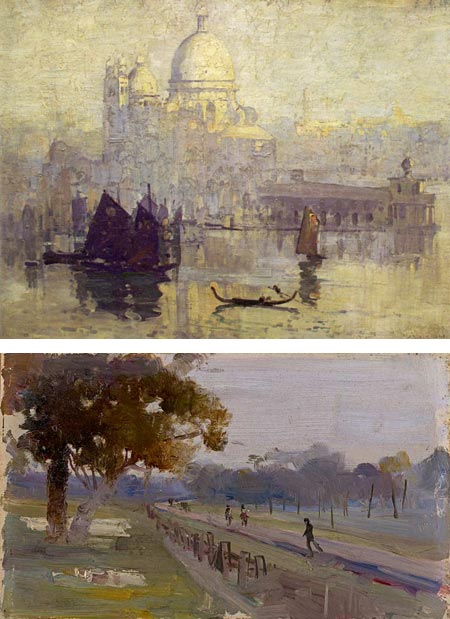
The practice of painting outdoors (or en plein air, see my recent post on pochade boxes), spread from France, where it first came into wide practice, to other parts of Europe, America, and other parts of the world, largely through the impact the French painters had on artists from other countries who came to the artistic centers of Europe to study.
Arthur Streeton was an Australian artist who, along with a small group of contemporaries, brought the practice, and the influence of the French Impressionists, to his homeland.
Largely self-taught as a young man, he became particularly impressed by what he read and saw in photographs of the works of the Barbizon School of French painters, particularly Corot, and later became influenced by the Impressionists, who inherited the practice from their Barbizon mentors.
Streeton’s formal study was at the National Gallery of Victoria School, and he went on plein air painting trips on the areas surrounding Melbourne. He joined groups of like-minded artists working in artist camps in Box Hill and Heidleberg (Victoria).
Along with Tom Roberts and Frederick McCubbin, he participated in the first show of Impressionist influenced works in Australia. The show was called the “9 by 5 Impression Exhibition” and consisted largely of plein air paintings on cigar box lids of that size (image above, bottom).
Like the American Impressionists, the Australian painters were not so much devotees of Impressionist theory, as simply painters who adopted what they liked from the Impressionist approach into their own unique style.
Streeton moved to London, after passing through Cairo, where he painted for five months, and then Naples. He moved back to Australia, then back to England; and then traveled Europe, including a notable stint of painting in Venice. Back to Australia again and then back to England, where he joined the British Army medical Corps in the course of the First World War.
He eventually returned to Australia and became one of the most notable and successful of Australian artists.
His bright, fresh color and lively brushwork are evident in both his cigar box sketches and his larger finished work.

Comments
6 responses to “Arthur Streeton”
Thanks for this, I discovered this guy in a book on painting Orientials. His work was simply majestic!
Thanks for all the links too, I have been trying to do some research on this guy ever since.
I am surprised I haven’t been exposed to this painter. What a impressionism master! Muted colors, broken lines, images melting into the soft background, beautiful blending. Thanks for your remarks, Charley.
Cheers, great post. An amazing inspiration to aussie environment painters.
A great book to get hold of is Australian Impressionism put together by the National Gallery of Victoria last year.
I’m an Australian born water-colourist and book illustrator and have been exposed to the Box Hill and Aust Impressionists all my life; I thought that I’d become rather immune to their attractions but the Venetian painting in your post caught my eye; A Streeton I’ve not seen before and a spur to investigate his work further, thank you. However, I still hold the view that our – Australia’s – greatest, and truly, most impressionist of painters was John Peter Russell. He was a familiar of van Gogh and Emile Bernard and he was married to one of Rodin’s former models. To my mind his works are equal to those of Monet and Renoir at their best. His portrait of van Gogh, 1886, Rijksmuseum, Amsterdam, is a beautiful work and one that sees Vincent differently to those contemporaries who saw only the hints of his coming madness.Have a look at his work and see if I’m not at least half right in my estimation of his worth.
Thanks for the privilege.
Streeton in his youth was like a supernova. He burst onto the scene and in his very early teens was producing master works unique in Australian art. He had only cursory training in the then fledgling National School but developed and honed his skill through his very close association with both Tom Roberts and Charles Conder. Streeton’s style in those early years was both individualistic and unique. But it wasn’t to last. He was impatient to travel to the ‘mother country’ and to chance his hand over there. His art suffered enormously as a consequence. His originality and adventurism as a youth drained away as he grew older and as he began to follow what he thought were the more acceptable styles and fashions of the Edwardian period in the mother country. In the 40 odd years since he first left Australia’s shores, though he returned to Australia, he never again recovered the startling genius of his youth.
If you ever get to the National Gallery in Canberra, if it is not on loan, go and see Streeton’s “Golden Summers” – tell me that you don’t feel like you are standing in a golden field in the heat of the Australian summer.